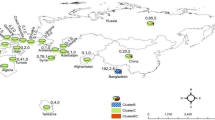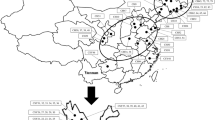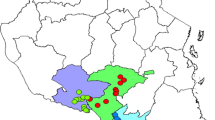Abstract
Grass pea (Lathyrus sativus L.) is a legume crop known to be an excellent source of protein, tolerant to drought, waterlogging, and salinity. The crop is used as an alternative source of protein to reduce malnutrition for resource-poor people and farmers leaving in marginal areas. However, due to the presence of a neurotoxin that causes lathyrism in the crop, it has been neglected and underutilized. As a necessary first step towards, therefore, this investigation was undertaken to assess the genetic diversity and population structure that existed within grass pea accessions collected from North-West Ethiopia using simple sequence repeat markers. Twenty-five grass pea accessions collected from the Ethiopian Biodiversity Institute were planted at the College of Agricultural Science, Ebonyi State University, Nigeria. The genomic DNA was extracted using Quick-DNA™ ZR Plant/Seed Miniprep Kit and amplified in an ABI Veriti PCR machine with 10 pairs of SSR markers in IITA, Ibadan, Nigeria. Out of 10 SSR primers, only eight primers were polymorphic. A total of 41 alleles were detected with an average of 5.13. The Polymorphism Information Content and Gene Diversity values ranged from 0.074 to 0.944 with a mean of 0.474 and 0.536 respectively. The largest pairwise genetic distance (0.365) was detected between North Gondar and East Gojjam populations. The ФPT (analog of FST test) estimated through AMOVA were 0.24, 0.20, and 0.05 for within accessions, among regions, and population within regions respectively. The highest genetic differentiation value (76%) resides within accessions followed by 20% among regions. Both the population structure and cluster analyses grouped the 25 grass pea accessions into two distinct subgroups. This grouping pattern indicates the presence of gene flow among geographic regions. In general, the findings of this study indicate that despite few numbers of SSR markers it was possible to detect genetic diversity among grass pea accessions indicating the power of the SSR marker in picking up the existing genetic diversity within the studied accessions.








Similar content being viewed by others
References
Aci MM, Lupini A, Badagliacca G, Mauceri A, Lo Presti E, Preiti G (2020) Genetic diversity among Lathyrus ssp. based on agronomic traits and molecular markers. Agronomy 10:1182–1197. https://doi.org/10.3390/agronomy10081182
Akter L, Mahbub M, Habib MA, Alam SS (2015) Characterization of three varieties of Lathyrus sativus L by fluorescent karyotype and RAPD analysis. Cytologia 80:457–465. https://doi.org/10.1508/cytologia.80.457
Arslan M, Basak M, Aksu E, Uzun B, Yol E (2020) Genotyping of Low β-ODAP Grass Pea (Lathyrus sativus L.) Germplasm with EST-SSR Markers. Braz Arch Biol Technol 63:1–13. https://doi.org/10.1590/1678-4324-2020190150
Asadova A, Babayeva S, Izzatullayeva V, Akbarova S, Aghazade G, Mirzaliyeva I, Abbasov M (2020) Molecular characterization of L. sativus L. collection based on ISSR markers. Genetika 52:777–786. https://doi.org/10.2298/GENSR2002777A
Barik DP, Acharya L, Mukherjee AK, Chand PK (2007) Analysis of genetic diversity among selected grass pea (Lathyrus sativus L.) genotypes using RAPD markers. Z Naturforsch 62:869–874
Belaid Y, Chtourou-Ghorbel N, Marrakchi M, Trifi-Farah N (2006) Genetic diversity within and between populations of the Lathyrus genus (Fabaceae) revealed by ISSR markers. Genet Resour Crop Evol 53:1413–1418. https://doi.org/10.1007/s10722-005-5680-0
Campbell CG (1997) Grass pea, Lathyrus sativus L, vol 18. Bioversity International
Chtourou-Ghorbel N, Lauga B, Combes D, Marrakchi M (2001) Comparative genetic diversity studies in the genus Lathyrus using RFLP and RAPD markers. Lathyrus Lathyrism Newsletter 2:62–68
Croft A, Pang E, Taylor P (1999) Molecular analysis of Lathyrus sativus L. (grass pea) and related Lathyrus species. Euphytica 107:167–176. https://doi.org/10.1023/A:1003520721375
CSA (2020) The Federal Democratic Republic of Ethiopia, Central Statistical Agency, Agricultural Sample Survey 2019/2020 (2012 E.C.). Volume I. Report on Area and Production of Major Crops (Private Peasant Holdings, Meher Season). Statistical Bulletin, April 2020, Addis Ababa, Ethiopia
Dixit GP, Parihar AK, Bohra A, Singh NP (2016) Achievements and prospects of grass pea (Lathyrus sativus L.) improvement for sustainable food production. Crop J 4:407–416. https://doi.org/10.1016/j.cj.2016.06.008
Earl DA (2012) STRUCTURE HARVESTER: a website and program for visualizing STRUCTURE output and implementing the Evanno method. Conserv Genet Resources 4:359–361. https://doi.org/10.1007/s12686-011-9548-7
Ethiopian Biodiversity Institute/EBI, Material holding, accessed 7 Sep 2021. Retrieved from https://www.ebi.gov.et/biodiversity/conservation/database-ms/
Evanno G, Regnaut S, Goudet J (2005) Detecting the number of clusters of individuals using the software STRUCTURE: a simulation study. Mol Ecol 14:2611–2620. https://doi.org/10.1111/j.1365-294X.2005.02553.x
Falush D, Stephens M, Pritchard JK (2003) Inference of population structure using multilocus genotype data: linked loci and correlated allele frequencies. Genetics 164:1567–1587. https://doi.org/10.1093/genetics/164.4.1567
Girma D, Korbu L (2012) Genetic improvement of grass pea (Lathyrus sativus) in Ethiopia: an unfulfilled promise. Plant Breed 131:231–236. https://doi.org/10.1111/j.1439-0523.2011.01935.x
Gupta P, Udupa SM, Gupta DS, Kumar J, Kumar S (2018) Population structure analysis and determination of neurotoxin content in a set of grass pea (Lathyrus sativus L.) accessions of Bangladesh origin. Crop J 6:435–442. https://doi.org/10.1016/j.cj.2018.03.004
Hillocks R, Maruthi M (2012) Grass pea (Lathyrus sativus): Is there a case for further crop improvement? Euphytica 186:647–654. https://doi.org/10.1007/s10681-012-0702-4
Kopelman NM, Mayzel J, Jakobsson M, Rosenberg NA, Mayrose I (2015) Clumpak: a program for identifying clustering modes and packaging population structure inferences across K. Mol Ecol Resource 15:1179–1191. https://doi.org/10.1111/1755-0998.12387
Lambein F, Travella S, Kuo YH, Van Montagu M, Heijde M (2019) Grass pea (Lathyrus sativus L.): orphan crop, nutraceutical or just plain food? Planta 250:821–838. https://doi.org/10.1007/s00425-018-03084-0
Lioi L, Sparvoli F, Sonnante G, Laghetti G, Lupo F, Zaccardelli M (2011) Characterization of Italian grass pea (Lathyrus sativus L.) germplasm using agronomic traits, biochemical and molecular markers. Genet Resour Crop Evol 58:425–437. https://doi.org/10.1007/s10722-010-9589-x
Liu K, Muse SV (2005) PowerMarker: an integrated analysis environment for genetic marker analysis. Bioinformatics 21:2128–2129. https://doi.org/10.1093/bioinformatics/bti282
Louette D, Charrier A, Berthaud J (1997) In situ conservation of maize in Mexico: genetic diversity and maize seed management in a traditional community. Econ Bot 51:20–38. https://doi.org/10.1007/BF02910401
Mahapatra NS, Das A, Bhattacharyya PK, Bhattacharya S (2020) Studies on genetic variability, divergence and association of characters in grass pea. J Crop Weed 16:155–161
Parihar A, Dixit G, Singh D (2015) Genetic variability analysis for quantitative traits in a germplasm set of grass pea (Lathyrus spp.). Legume Res Int J 38:461–464. https://doi.org/10.5958/0976-0571.2015.00027.2
Parihar A, Dixit G, Singh D (2013) Multivariate analysis of various agronomic traits in grass pea (Lathyrus spp) germplasm. Indian J Agric Sci 83:570–575
Peakall ROD, Smouse PE (2006) GENALEX 6: genetic analysis in Excel. Population genetic software for teaching and research. Mol Ecol Notes 6:288–295. https://doi.org/10.1111/j.1471-8286.2005.01155.x
Pritchard JK, Stephens M, Donnelly P (2000) Inference of population structure using multilocus genotype data. Genetics 155:945–959. https://doi.org/10.1093/genetics/155.2.945
Rafaat JG, Ghareeb SA, Hasan SS (2021) Effect of sowing dates on growth, yield, and its components of Grass Pea (Lathyrus Sativus) varieties under rainfed condition in Sulaimani Region. Tikrit J. Agric. Sci. 21:59–67. https://doi.org/10.25130/tjas.v21i1.477
Rohlf, F. J. (1997). NTSYS-pc. Numerical taxonomy and multi variance analysis system version2.02 e. Exeter Software, New York, USA
Shiferaw E, Pè M, Porceddu E, Ponnaiah M (2012) Exploring the genetic diversity of Ethiopian grass pea (Lathyrus sativus L.) using EST-SSR markers. Mol Breed 30:789–797. https://doi.org/10.1007/s11032-011-9662-y
Soren KR, Konda AK, Gangwar P, Tiwari VA, Shanmugavadivel PS, Parihar AK, Dixit GP, Singh NP (2020) Development of SSR markers and association studies of markers with phenology and yield-related traits in grass pea (Lathyrus sativus). Crop Pasture Sci 71:768–775. https://doi.org/10.1071/CP19557
Soren KR, Yadav A, Pandey G, Gangwar P, Parihar AK, Bohra A, Dixit GP, Datta S, Singh NP (2015) EST-SSR analysis provides insights into genetic relatedness, population structure, and gene flow in grass pea (Lathyrus sativus). Plant Breed 134:338–344. https://doi.org/10.1111/pbr.12268
Tadesse W, Bekele E (2003a) Phenotypic diversity of Ethiopian grass pea (Lathyrus sativus L.) with geographical regions and altitudinal range. Genet Resour Crop Evol 50:497–505. https://doi.org/10.1023/A:1023923813312
Tadesse W, Bekele E (2003b) Variation and association of morphological and biochemical characters in grass pea (Lathyrus sativus L.). Euphytica 130:315–324. https://doi.org/10.1023/A:1023087903679
Talukdar D (2009) Recent progress on genetic analysis of novel mutants and aneuploid research in grass pea (Lathyrus sativus L.). Afr J Agric Res 4:1549–1559. https://doi.org/10.5897/AJAR.9000582
Tokarz KM, Wesołowski W, Tokarz B, Makowski W, Wysocka A, Jędrzejczyk RJ, Kostecka-Gugała A (2021) Stem Photosynthesis—A Key Element of Grass Pea (Lathyrus sativus L.) Acclimatisation to Salinity. Int J Mol Sci 22:685–718. https://doi.org/10.3390/ijms22020685
Tavoletti S, Iommarini L (2007) Molecular marker analysis of genetic variation characterizing a grass pea (Lathyrus sativus) collection from central Italy. Plant Breeding 126:607–611. https://doi.org/10.1111/j.1439-0523.2007.01407.x
Urga K, Fufa H, Biratu E, Husain A (2005) Evaluation of Lathyrus sativus cultivated in Ethiopia for proximate composition, minerals, β-ODAP, and anti-nutritional components. Afr J Food Agric Nutr Dev 5:1–16
Uysal H, Acar Z, Ayan I, Kurt O (2018) Genetic diversity of Turkish Lathyrus L. landraces using ISSR markers. Genetika 50:395–402. https://doi.org/10.2298/GENSR1802395U
Wang F, Yang T, Burlyaeva M, Li L, Jiang J, Fang L, Redden R, Zong X (2015) Genetic diversity of grass pea and its relative species revealed by SSR markers. PLoS ONE 10:e0118542. https://doi.org/10.1371/journal.pone.0118542
Wiraguna E, Malik AI, Colmer TD, Erskine W (2020) Waterlogging tolerance of grass pea (Lathyrus sativus L.) at germination related to the country of origin. Exp Agric 56:837–850. https://doi.org/10.1017/S0014479720000356
Wright S (1978) Evolution and the genetics of populations: a treatise in four volumes: Vol. 4: variability within and among natural populations. University of Chicago Press
Yang T, Jiang J, Burlyaeva M, Hu J, Coyne CJ, Kumar S, Redden R, Sun X, Wang F, Chang J (2014) Large-scale microsatellite development in grass pea (Lathyrus sativus L.), an orphan legume of the arid areas. BMC Plant Biol 14:1–12. https://doi.org/10.1186/1471-2229-14-65
Acknowledgements
Special thanks to Ebonyi State University (EBSU), Faculty of Science and Department of Biotechnology, Abakaliki, Nigeria, and GENEs Intra-Africa Mobility Project EACEA/2017/2552 with Ref number EBSU/2018/GENES/MSc/ SCH-M/03 for hosting and sponsoring this research work. I appreciate Ethiopian Biodiversity Institute (EBI) for providing grass pea accessions. My superior acknowledgments go to Dr. Melaku Gedil of IITA Bioscience Lab, for his technical assistance, and for affording consumable chemicals used for the molecular part of the study throughout the Lab work.
Author information
Authors and Affiliations
Corresponding author
Additional information
Publisher's Note
Springer Nature remains neutral with regard to jurisdictional claims in published maps and institutional affiliations.
Rights and permissions
About this article
Cite this article
Mekonen, D.A., Abraham, A., Oselebe, H. et al. Genetic diversity and population structure analysis of Grass pea (Lathyrus sativus L.) accessions collected from North-Western Ethiopia using SSR markers. Genet Resour Crop Evol 69, 1247–1260 (2022). https://doi.org/10.1007/s10722-021-01302-5
Received:
Accepted:
Published:
Issue Date:
DOI: https://doi.org/10.1007/s10722-021-01302-5




